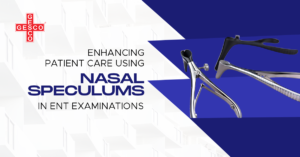Enhancing Patient Care Using Nasal Speculums in ENT Examinations
Are you tired of uncomfortable and inaccurate ENT examinations? Say goodbye to outdated methods and hello to a game-changer in patient comfort and precision – nasal speculums! In this blog post, we’ll dive into how this simple yet innovative tool is revolutionising the way ear, nose, and throat specialists conduct exams. Get ready to take your practice to the next level with improved patient care and accuracy like never before.
ENT (Ear, Nose, and Throat) examinations are essential for both diagnosing and treating a wide range of disorders affecting these organs. These tests involve a detailed assessment of the structures in these regions in order to spot abnormalities or possible problems that might be uncomfortable or harmful to general health.
Usually, an ENT examination begins with a thorough medical history review and a discussion of any symptoms or concerns with the patient. This enables the doctor to obtain crucial data and comprehend the patient’s general health before implementing more intrusive procedures. However, a physical examination with specialised tools like nasal speculums is one of the most crucial parts of an ENT exam.
A medical instrument called a nasal speculum is used to look inside the nose. To improve vision and access to the nasal cavity, it consists of two blades that are gently expanded after being inserted into each nostril. This makes it possible for medical professionals to carefully inspect the nose’s lining and structure for any indications of growths, infections, inflammation, or other anomalies.
The common types of nasal speculums available and their uses.
1. Anterior Rhinoscopy: One of the most popular nasal speculums is anterior rhinoscopy. They have two angled blades that open up the nostrils and give an examination-ready view of the nasal cavity. These speculums are perfect for examining the front part of the nose and identifying any pathologies or anomalies.
2. Posterior Rhinoscopy: Using curved blades, posterior rhinoscopy allows visualisation of the nasopharynx and the adenoidal region, two posterior nasal cavity regions. Patients with allergies or chronic sinusitis are frequently examined with this kind of nasal speculum.
3. Sphenoid Sinus Speculums: These instruments were created specifically to examine the sphenoid sinuses, which are situated behind your eyes at the back of your nose. Their high-intensity light source allows for direct visualisation without causing any damage to the surrounding tissue. In order to remove any debris or secretions, this type may also include extra tools like an irrigation port or suction tube.
4. Microspecula: Depending on their intended usage, microspecula can vary in size, but they usually have a thin metal shaft with tiny, spoon-shaped blades at the tip, making them perfect for gently retracting mucosa during a biopsy or examination procedure.
5.Peanut Nasal Speculum: This tool is useful for diagnosing tumours in narrow passages and performing turbinectomy procedures. It resembles peanut-shaped blades attached to handles on both sides that can be opened horizontally like tweezers to provide a wider field of view into smaller openings.
6. Nasal Endoscopes: Designed to visualise the sinuses and inner nasal cavity, nasal endoscopes are thin tubes with a light and camera attached to the tip. With the help of these speculums, one can examine the nasal mucosa, septum, turbinates, and other structures that conventional speculums might not be able to see.
Additionally, some nasal specula may have features like adjustable blades or detachable tips to fit a range of patient sizes or make it simpler to access different parts of the nose.
The particular requirements of each patient and their ENT condition determine the kind of nasal speculum that is used. For optimal diagnostic accuracy and patient comfort during examination, an ENT practice should have a range of these devices on hand.
A precise diagnosis during an ENT examination depends on the ability to visualise the nasal passages accurately. Nasal speculums provide a clear, unobstructed view of the nasal mucosa, septum, turbinates, and any potential abnormalities, which makes this easier. By making these structures easier for medical professionals to see, nasal speculums aid in the detection of conditions such as deviated septum, nasal polyps, foreign bodies, and signs of inflammation or infection.
One of the main advantages of using nasal speculums is that they increase patient comfort during examinations. Compared to more aggressive techniques like manual nasal manipulation, which can be painful or uncomfortable, speculums offer a more delicate approach. When a speculum is used to carefully expand the patient’s nostrils, the patient feels less discomfort, leading to a more favourable
Nasal speculums are vital for several therapeutic procedures performed in ENT settings, in addition to diagnostic examinations. For instance, they are frequently used in nasal endoscopy, rhinoplasty, septoplasty, and sinus procedures. Speculums provide surgeons with optimal visibility and access to the nasal cavity, enabling them to carry out procedures with greater accuracy and efficiency, ultimately leading to better treatment outcomes.
Nasal speculums are safe, hygienic, and helpful in clinical settings. The majority of speculums are made of medical-grade materials that can be easily sterilised and cleaned, which reduces the chance of cross-contamination between patients. Disposable speculums are provided for single-use applications in order to further lower the risk of infection transmission.
In conclusion, nasal speculums are essential for improving patient care in the field of otolaryngology. These devices help to make ENT exams and procedures more efficient by increasing patient comfort, increasing diagnostic accuracy, streamlining treatment procedures, and promising hygienic and safe practices. In order to maximise patient outcomes and overall quality of care, healthcare providers need to acknowledge the significance of nasal speculums and integrate them into their clinical practice.
visit our website now now to know more.

